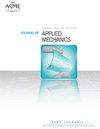The Mechanics Difference Between The Outer Torus and Inner Torus
IF 2.8
4区 工程技术
Q2 MECHANICS
引用次数: 1
Abstract
The formulation used by the most of studies on elastic torus are either Reissner mixed formulation or Novozhilov's complex-form one, however, for vibration and some displacement boundary related problem of torus, those formulations face a great challenge. It is highly demanded to have a displacement-type formulation for torus. In this paper, we will carry on author's previous work [B.H. Sun, Closed-form solution of axisymmetric slender elastic toroidal shells. J. of Engineering Mechanics, 136 (2010) 1281-1288.], and with the help of our own maple code, we are able to simulate some typical problems of torus. The numerical results are verified by both finite element analysis and H. Reissner's formulation. Our investigations show that both deformation and stress response of an elastic torus are sensitive to the radius ratio, and suggest that the analysis of a torus should be done by using the bending theory of a shell, and also reveal that the inner torus is stronger than outer torus due to the property of their Gaussian curvature. One of the most interesting discovery is that the crowns of a torus are the turning point of the Gaussion curvature at ϕ = 0, π, where the mechanics response of inner and outer torus is almost separated.外环面与内环面的力学差异
弹性环面的研究大多采用Reissner混合公式或Novozhilov复形公式,但对于环面的振动和一些与位移边界有关的问题,这些公式面临着很大的挑战。对环面的位移式公式要求很高。在本文中,我们将继承作者之前的工作[B.H.轴对称细长弹性环面壳的闭型解。工程力学学报,36(2010):1281-1288。],在我们自己的maple代码的帮助下,我们能够模拟一些典型的环面问题。数值结果得到了有限元分析和H. Reissner公式的验证。我们的研究表明,弹性环面的变形和应力响应对半径比都很敏感,并表明环面的分析应采用壳的弯曲理论,并且由于其高斯曲率的性质,内环面比外环面更强。其中一个最有趣的发现是,环面的顶点是高斯曲率在φ = 0, π处的转折点,在那里,内外环面的力学响应几乎是分离的。
本文章由计算机程序翻译,如有差异,请以英文原文为准。
求助全文
约1分钟内获得全文
求助全文
来源期刊
CiteScore
4.80
自引率
3.80%
发文量
95
审稿时长
5.8 months
期刊介绍:
All areas of theoretical and applied mechanics including, but not limited to: Aerodynamics; Aeroelasticity; Biomechanics; Boundary layers; Composite materials; Computational mechanics; Constitutive modeling of materials; Dynamics; Elasticity; Experimental mechanics; Flow and fracture; Heat transport in fluid flows; Hydraulics; Impact; Internal flow; Mechanical properties of materials; Mechanics of shocks; Micromechanics; Nanomechanics; Plasticity; Stress analysis; Structures; Thermodynamics of materials and in flowing fluids; Thermo-mechanics; Turbulence; Vibration; Wave propagation

 求助内容:
求助内容: 应助结果提醒方式:
应助结果提醒方式:


